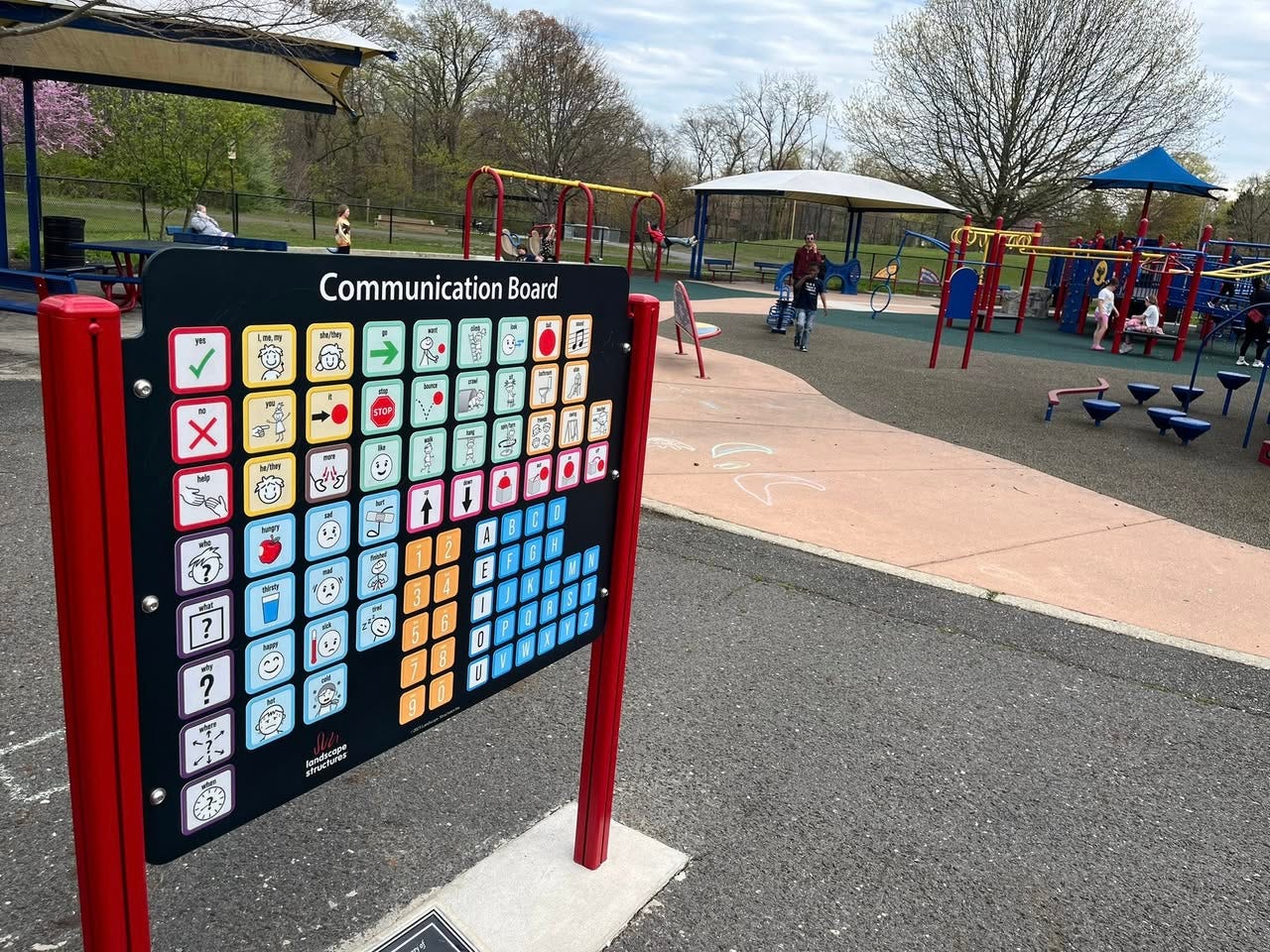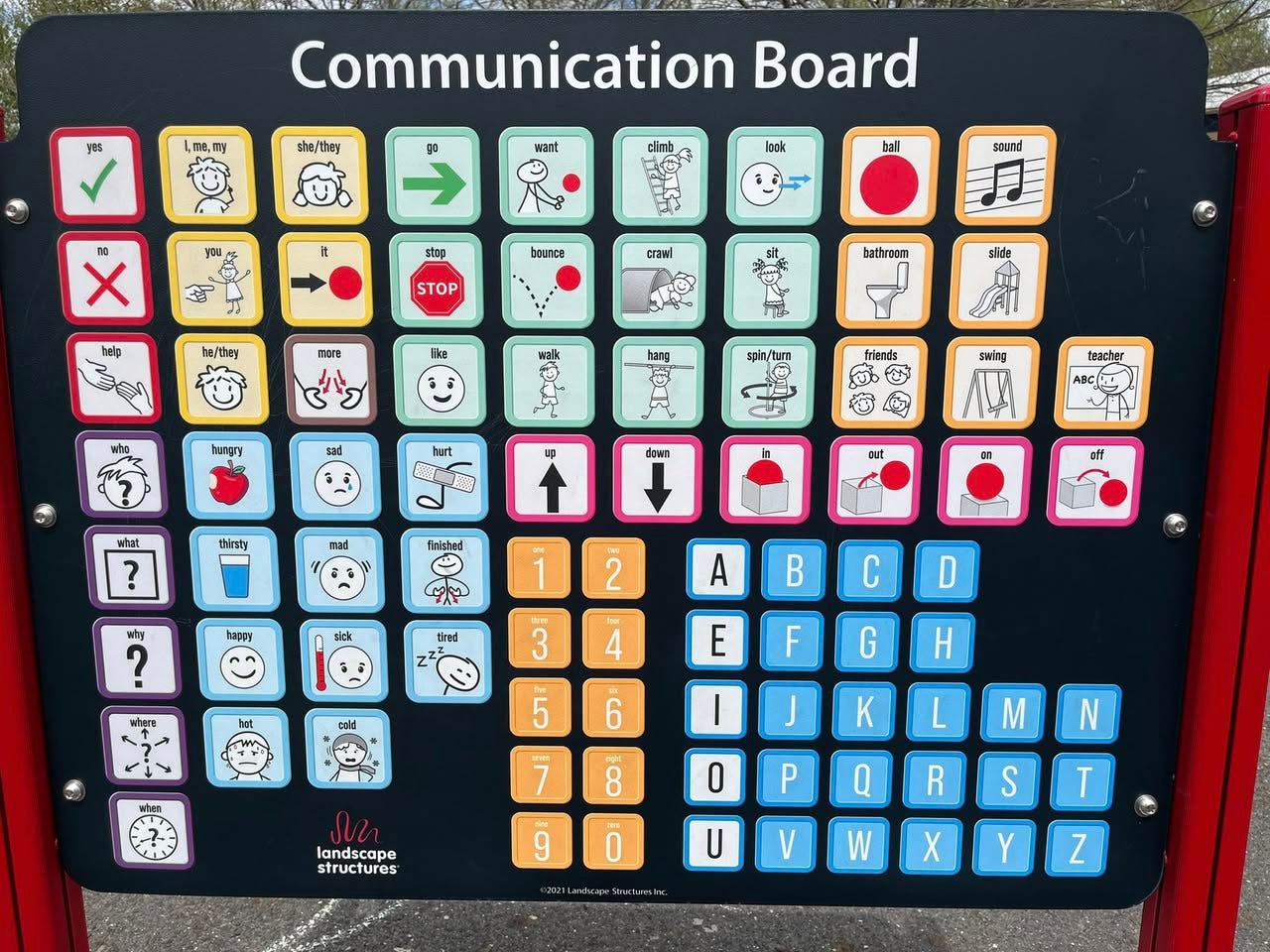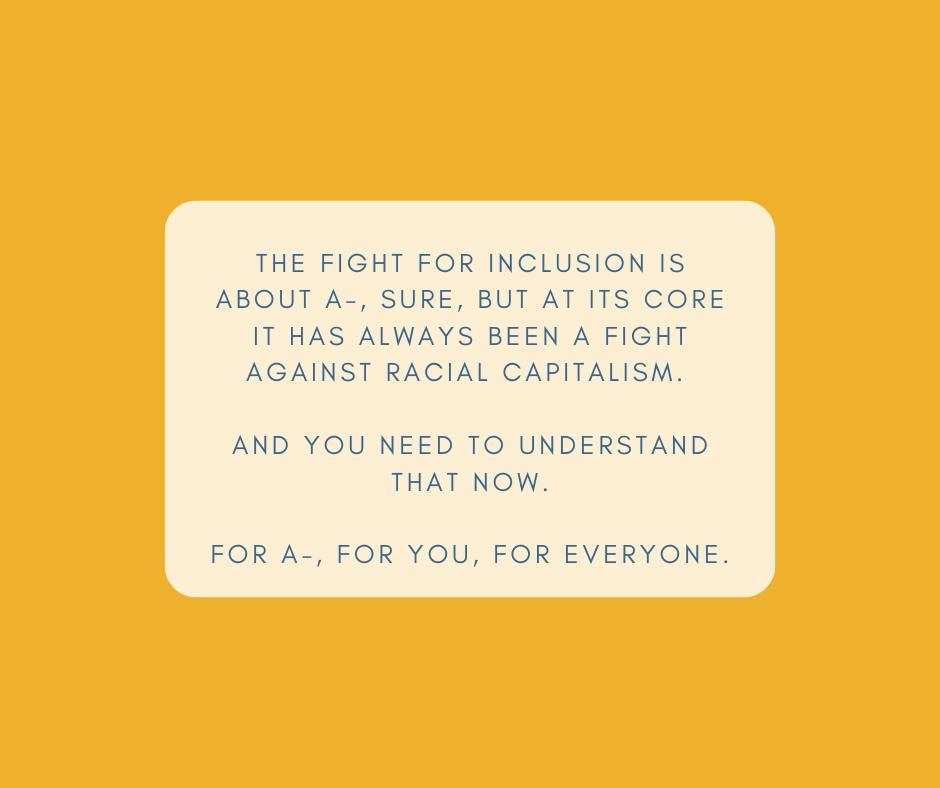The fight for inclusion is about whether you can be disappeared right now
Also no country is safe; bathrooms; complex AAC; parents vs disabled folks; changing minds; love abounds; novelty; intersectionality; frameworks
In this newsletter…
An example of practical skills one can work on that aren’t “using the toilet” (Apr 11)
The tension between disability rights advocates and parents of disabled kids (Apr 13)
The fight for inclusion is about whether you can be disappeared right now (Apr 16)
Embodying intersectionality aka My Grandmother’s Hands (Apr 17)
What I’m listening to and reading…
Apparently a special interest of mine is men talking about love. Here’s an interview with Kiese Leymon on many things including being wired to love everyone - even Trump - that reminded me of
’s book.The nonviolent Medicaid Army has a series called “Saturday School of Struggle” and May’s topic is Basebuilding - yes even with, or especially with, people who don’t have the same views as you do.
An example of practical skills one can work on that aren’t “using the toilet” (Apr 11)
This isn’t about A- specifically, since I don’t share about his hygiene. But they are some ideas our OT had for any kid who using the toilet might not be a possible goal right now, but you’re trying to figure out other age-necessary goals to work on to promote dignity.
One thing to work on could be just making an association between a bathroom, and peeing and pooping. This may be learning that after one pees / poops, a bathroom is the appropriate place to go change your diaper!
So some ideas around that:
have kid help throw away a soiled diaper (for a poop diaper you could put it in a plastic bag and tie it so it doesn’t make a mess).
have diapers / wipes stored in the bathroom. Even if it’s just a couple because your bathroom is tiny. That way you’re getting supplies from the bathroom
put the poop in the toilet and you or kid flush, before throwing away the diaper. If this isn’t logistically possible it could just be symbolic or a speck of the poop
if your kid likes words, put stickers on bathroom things like trash can, toilet, wipes, sink, etc
put photos of fun things up in the bathroom, like buses, so the bathroom is fun. If your kid is very sensitive to smell, then a nice aromatic diffuser
when out and about, go to the bathroom at regular intervals to check the diaper. This has the added bonus of not always changing a diaper in the bathroom but knowing that’s where that happens.
if possible, hand washing in the bathroom. Hand washing is a LOT of steps so it could be sanitizer instead, or even those “no rinse soaps” (we have that if someone wants a link). They foam like soap and you *can* use them as soap, but it’s ok if you don’t.
Those were some ideas! The goal isn’t to use a toilet - but that can certainly come out of this! But this also lays building blocks for someone to use incontinence products in a more dignified, respectful, and self-driven way!
On AAC is complex! (Apr 12)
It’s taken me a long time to realize that even when it comes to high tech speech generating devices, AAC isn’t just using an icon based app until someone can spell, and then it’s text to speech.
In the past couple of months, I’ve spoken to parents and AAC users themselves who:
had icon based AAC modeled intensely for years and could never use it, and then were quickly able to spell on a physical keyboard (the icons proved to have motor planning challenges, they said)
use icon based AAC in some contexts and for some kinds of thoughts, and spell for others
can’t use icon based or spelling and use visual scenes and YouTube videos
use an app set up for “slot and frame” (so like fill in the blanks) communication (despite being a stage 4-6 GLP)
I’m sure there are countless other examples. I’m sure for young people, it changes as they grow up.
And this makes sense. We talk about speaking autistic folks having a “spiky profile” with communication. Sometimes speaking a lot, sometimes needing AAC. It follows that a non-speaker would have a spiky profile where their access to typical-language and their motor abilities change based on the time, the context, the need, the thought they want to express, and therefore their ability to use a specific modality changes.
I started this blog when A- was around 2 and we went all in on icon-based AAC. I expected this to be a blog like the Nieder’s - showing how we help A- progress to use the icons to express himself. Instead we’ve found that, right now anyway, this isn’t how he’s communicating. And we haven’t found the right mix of options for him (and he’s growing), but there are a LOT of possibilities and there’s no way we could be discovering them if we weren’t letting him lead.
Blogs I’ve learned from:
The tension between disability rights advocates and parents of disabled kids (Apr 13)
There’s a new book called Allies and Obstacles by Allison Carey about the tensions between disability rights advocates and parents of disabled kids. I’m told the book itself is written in a heavy academic style but this interview is great.
It reminds me of my vision to have an org like PFLAG for parents of disabled kids. A way to bring parents into the disability justice movement. To learn and grow together. To ask stupid questions and sort through emotions, in private.
It’s why I’m starting to think we don’t need another guide-for-parents-new-to-diagnosis that says “hey here’s autism”. We need a guide that says “hey here’s disability and disability justice.” Every new parent at least needs to be handed a copy of We Move Together.
She talks about some real and relatable things like how capitalism puts unique pressures on parents of disabled kids. Pushing them towards “optimization”.
She also talks about what I’ve written about here. There are groups run by parents, for parents, which are naturally where a parent will gravitate towards. This often results in parent groups advocating for the opposite of what disability rights group advocate for (eg inclusion in schools).
But if a parent wants to gravitate to disability orgs, we’re just considered “allies”. I’d go further and say that it’s very very very hard to even find a space like that where a non disabled parent can go and be a part of the movement! I’ve been looking for years! (Hence my desire for a PFLAG-like space).
I wonder if orgs focused on across-identities Medicaid fights, like Nonviolent Medicaid Army, incorporate political education on disability justice into their work, as a way to broaden the base?
Changing minds: music therapy (Apr 14)
This week I had our parent-teacher conference with A-'s music therapists. Our situation is a bit unique, since Daniel is always with A- and is incorporated into music therapy, but it's fun for me to talk to them because I get to see videos of what A- experiences!
Some of you may remember that last Fall, Daniel wrote an incredibly great letter to the music therapists about how A- doesn't need to have his play altered (even slightly) and that there are so many ways that music can be incorporated into his Ready Set Go game.
On the call, the grad student who has been working with A- said that while at the beginning he had to really reshape his attitude to how to let A-'s play really lead, once he did that, it really shifted his view towards A- and music therapy. He said he learned more from A- and this experience than A- did from him.
(And I don't just mean "child led", which they've claimed to be from the very beginning, I mean really, really, really child-driven).
So our advocacy really paid off!!! Not just for A-, but for this grad student, and maybe for the other clients he works with in the future.
Although one I wish I had a better response for their “improv” comments. I reflected that if A- is a Director, then over time he has to learn to collaborate with others. A Director may collaborate with a composer, for example (or suffer the consequences a la Mike White and White Lotus.). A-'s main music therapist was like "Yes! We give and take! It's like Improv! It's always Yes and!"
But I wish I had replied that yes, improv is amazing. But if a Director is trying to direct Macbeth, you can't just randomly swoop in and say "IT'S IMPROV NOW!!!!". It's improv when it is improv. And it's a Director-directed-play when it's a director-directed-play. And yes, ideally a director is hearing from the composer, the actors, the cinematographer, or whatever, but they are still the one directing. And this is how we play with A-. We introduce ideas but just as suggestions. Some he likes, some he throws away. The show is ultimately his perfect vision.
Being excited by natural language, aka love abounds (Apr 14)
My favorite thing about A- is that he can say “Amma” (which is his parent name for me) and he exclusively uses it to call me to him for Ready Set Go. Like if I get directed into the other room and I’m supposed to come back to him and I’m not doing it fast enough.
No “I love you Amma”. And I love it because it’s the perfect example of how his communication is entirely led by him, and what is the most important thing to him. Which is making sure we understand his directions perfectly during Ready Set Go.
AAC and novelty (Apr 15)
By total coincidence we stopped at this award winning inclusive playground on our long distance drive home from Grandma and Grandpa’s house.
This playground had a core communication board. Daniel took us over to look at it and since I said I had to go to the bathroom, Daniel tapped “I Go Bathroom” a couple of times. Then I did it. Then A- tapped “bathroom” “bathroom” “sit” (“sit” was right beside bathroom). And Daniel said “yes…Amma sits in the bathroom.” And then A- gave me permission to go use the bathroom
Those of you who follow me know that A- doesn’t really use his digital AAC device or low tech print outs, and he doesn’t let us model it. So it’s interesting he used it here! I think that A- needs novelty and this was a novel board, with words he recognized, and that’s why he used it. Daniel thinks it could have been the size, the environment, or all sorts of other things. All of these may be true! Daniel did have me take a photo of it so we can blow it up and see if A- wants to use it at home.
The fight for inclusion is about whether you can be disappeared right now (Apr 16)
If there’s just one thing people take away from this blog, it’s understanding that when I fight for A- to be included in school, I'm not just fighting for A- to be included in school, I am fighting against authoritarianism.
This question - do we include all kids in school or not - is actually racial capitalism embedded in our thinking.
"Capitalism requires inequality, and racism enshrines it." - Ruth Wilson Gilmore
When we embrace a system that decides which 2 year olds gets to be segregated - shoved away, hidden. Which 2 years olds are human and are not. It is NOT JUST ABOUT that 2 year old. It is about Medicaid being cut. It is about the police killing someone who doesn't speak. It is about about Americans being disappeared to an El Salvadorian prison. It is about allowing over 40,000 Palestinians to be murdered in a locked cage. When I talk about A- being included in school, make no mistake, I am talking about YOU being treated as a human being.
When I talk about A- being included in school, I’m not just talking about A- being included in school, I’m talking about ending a society built on the values that some people are more human than others. And some aren't human at all.
When I URGE and BEG you to just imagine what it would look like to have a school that is inclusive for A-, I am URGING and BEGGING you to imagine a nation, a world, where people aren't sliced and diced into a hierarchy that allows some people to not be human, to be disappeared, to be abandoned. Because now it’s you. Whether it's because you become disabled through aging, or because you aren't part of the multi-billionaire oligarch and your tech organization can no longer unionize. Or because you shared a social media meme about the President and now you're disappeared and no rule of law will bring you back.
Because if you cannot imagine a world where A- is fully, equally, human, then you must imagine a world where you are not human.
For folks who argued “but it’s hard” to include all kids in school equally, so is getting someone out of an El Salvadorean prison apparently. That's why you needed to do the work decades ago. Because now someone is saying “but it’s too hard”… about you.
That's why you can't with-outrage share an article or 2 about someone who just got stolen by ICE in front of their non-speaking autistic kid, but then say "I dunno... inclusion.... but my kid benefits so much from a smaller class". If you want segregation of some people, this is what you get.
This is how capitalism enshrines its values. It makes you believe you WANT it this way. It makes you believe this is the BEST and ONLY way. I too believed it - implicitly by my inaction - until A-. I too didn't really hear the voices of disability justice folks even though I tried to.
The fight for inclusion is about A-, sure, but at its core it has always been a fight against racial capitalism and you NEED to understand that yesterday - for A-, for you, for everyone.
Embodying intersectionality aka My Grandmother’s Hands (Apr 17)
As an add-on to Fidgets and Fries’ recent IG post…
Go read My Grandmother's Hands!!!!! It's a book for all people - white folks, Brown folks, Black folks.
And if you're white, do Me and White Supremacy (it's a workbook).
I'm glad you're reading social media posts but I proooooomise you that reading a bunch of social media posts telling you to do better is NOT going to help you do better. You have 1000s of years of oppressing and being oppressed in your body. A few memes isn't going to cut through that. There’s a reason why my list of resources for those learning about autism includes resources like My Grandmother’s Hands, that never mention autism once.
Frameworks aren’t ND-affirming! (Apr 17)
Virginia Spielmann is the head of the STAR institute and is a leader of Sensory Integration, and I love this post by her sooooo much. I’ve written a bunch about how you CANNOT just have a ND-affirming framework any more than you can just have an anti-racist framework.
I don’t care if it’s Floortime or made by Autism level up or whatever.
Q. Is there any part of SI that's affirming?
A. Yes with intentionality, effort, and unlearning of internalized ableism and more on the part of the therapist.
AND the how just isn't a short answer.
And taken a step further, I’ve written about how it’s a tenant of white supremacy to seek shortcuts and not do the actual hard work of examining your own ableism and understanding it will take lifetimes to dismantle it. I’ve never seen a person who actually runs one of these frameworks say this. It’s actually a really, really big deal that she did.
When no country is safe. (Apr 17)
There are a lot of heavy conversations happening in a lot of households right now. And I just wanted to give a glimpse into the heavy and surreal conversations we are having right now. Maybe to make it feel more real to me? Or maybe to make it feel less real to me.
A Black, visibly disabled, boy, who is very big for his age, who moves his body in atypical ways and makes atypical noises, and doesn't communicate in typical ways, is not safe anywhere. There is no magic country out there where he's suddenly safe.
It seems, the only thing we have protecting him is being known by his neighbors - something made infinitely harder by his segregation out of schools starting at the age of 2. I've written before about how we are a highly, highly visible family (white dad caregiving for him; Black boy who looks older than he is who's still in a stroller and plays atypically but with visible, contagious joy). This means we are hyper-surveilled which is bad, but has sometimes been good. Like when Daniel had to call the cops on a mob of people who were following him because one guy was screaming a lie that Daniel was kidnapping A-. Luckily the cop said "I know you guys from the playground!".
A- is at an age where he has about 2 or 3 years left of being perceived as a cute Black boy and starts being seen as a Black threat.
What does this mean... it means that as we make decisions, we have to remember that if we move somewhere after A- hits that age where he is being clearly seen as a threat, we lose whatever safety is afforded to him right now of being known in his neighborhood.







